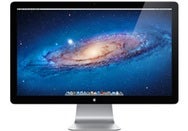Expert's Rating
Pros
- Can charge Apple laptops
- FireWire 800, USB, and ethernet connectivity
- Single cable from Mac cuts down clutter
Cons
- Stand lacks flexibility
- Few customization options
- Reflective screen limits display placement
Our Verdict

From most angles, Apple’s 27-inch Thunderbolt Display looks just like the 27-inch LED Cinema Display () released last year. However, if you take a closer look at what the Thunderbolt Display has to offer, you’ll find a display that’s ideal for owners of the Thunderbolt-equipped MacBook Air.
Glance at the back of the Thunderbolt Display, down at the lower left side, and you’ll find twice the number of connection ports as the LED Cinema Display. Like its predecessor, the Thunderbolt Display has three USB 2.0 ports, but it also has a FireWire 800 port, a gigabit ethernet port, and a Thunderbolt port.
The only other external difference is the display’s captive cable, which now splits into two connectors instead of three—a Mag Safe adapter for charging laptops, and a Thunderbolt cable, which takes the place of the separate Mini DisplayPort and USB 2.0 connectors found on the LED Cinema Display.
The Thunderbolt Display has a resolution of 2560 by 1440 pixels, a brightness rating of 375 cd/m2, support for displaying 16.7 million colors, a 1000:1 contrast ratio, 178 degree viewing angles, a built-in microphone, and a 49-watt speaker system—features that are all identical to the LED Cinema Display. The built-in camera has been updated from a standard iSight to a FaceTime HD camera.
The Thunderbolt Display requires OS X 10.6.8 or later, and a Thunderbolt-equipped Mac, such as the 2011 MacBook Air, MacBook Pro, Mac mini, or iMac. The Mac Pro is the only line of Apple’s computers yet to be updated with Thunderbolt, and you can’t plug the Thunderbolt Display into a Mac Pro’s Mini DisplayPort—or any Mac’s Mini DisplayPort—and expect it to work. It won’t, which is why Apple still sells the LED Cinema Display.
Making adjustments
Apple doesn’t provide much in the way of ergonomic adjustments. You can’t raise, lower or pivot the display. Apple doesn’t offer an anti-glare screen option for the display, so using the Thunderbolt Display in an area with a lot of light sources can be problematic.

Sharing the monitor between two Macs is also tricky. Many displays offer multiple inputs and the ability to easily cycle through the attached computers, but the Thunderbolt Display doesn’t offer such features. You can attach a second Thunderbolt-equipped Mac to the display by using Apple’s $49 Thunderbolt cable and connecting the second Mac to the display’s Thunderbolt port, but you’ll need to then physically disconnect the display’s captive Thunderbolt cable from the first Mac in order for the second Mac to take over the screen.
Making connections
What you can and can’t attach to each Thunderbolt Mac and the Thunderbolt Display is a little confusing. Systems with integrated graphics, such as the MacBook Air and the $599 Mac mini, can support two displays. The Air’s built-in screen counts as one display, meaning you can use it with one external Thunderbolt display. Laptops with discreet graphics can use three displays; the MacBook Pro can have two external displays working while its built-in screen is operational.
If you have a Thunderbolt Display, you can connect a second Thunderbolt Display to it. You can’t connect an LED Cinema Display to the Thunderbolt port of the Thunderbolt Display, but in our testing, when we attached the Promise Pegasus R6 Thunderbolt RAID, we were able to connect a LED Cinema Display (which uses Mini DisplayPort) to the Pegasus R6’s second Thunderbolt port.
The 2011 27-inch iMac has two Thunderbolt ports. You can connect a Thunderbolt Display to one of the Thunderbolt ports, and then connect another Thunderbolt display to the first Thunderbolt Display. You can also connect a LED Cinema Display or a third Thunderbolt Display to the iMac’s second Thunderbolt port, for a total of four 27-inch displays. Crazy.
The Thunderbolt Display should be most attractive to owners of the 2011 MacBook Air—and, in turn, the Thunderbolt Display makes the MacBook Air a more compelling choice for a computer. The display brings some seriously fast I/O connections to Apple’s smallest laptop. Before the Thunderbolt Display, connecting a MacBook Air to a wired LAN required an optional USB to Ethernet connector, and external drives were limited to pokey USB 2.0 transfer speeds. Now, MacBook Air users can use gigabit ethernet and FireWire 800 through the Thunderbolt Display.
Image quality
Macworld Lab used a ColorMunki Photo to calibrate the Thunderbolt Display. For comparison, we also looked at the 27-inch iMac, the 27-inch LED Cinema Display, and an HP ZR30w. The displays were set to a D65 white point, a 2.2 gamma and 100 cd/m2 brightness. As expected, the Thunderbolt Display looked just like the LED Cinema Display. I didn’t find any dead or stuck pixels, or light leakage from the edges. Uniformity was not a problem across the screen.
The wide viewing angle means that when sharing the screen, people next to you are seeing the same thing as you are, color-wise. There was very little loss of contrast as you move left to right or up and down from center. Grays were neutral after calibration, and the glossy screen really helps photos look richer but not overblown, with deep blacks.
Macworld’s buying advice
For owners of the 2011 MacBook Air, the Thunderbolt Display is a fantastic way to get iMac-like features while still being able to walk away with one of the lightest laptops available. If your Mac has Thunderbolt, FireWire 800, and gigabit ethernet, the case for buying the comparatively inflexible Thunderbolt display is a little less interesting.
[James Galbraith is Macworld’s lab director.]